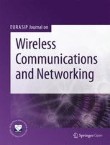EURASIP Journal on Wireless Communications and Networking welcomes submissions to the special issue on 'Millimeter-Wave Communications for 5G Networks'
The last ten years have witnessed explosive growth in mobile data traffic due to the rapid proliferation of Internet-connected smart devices. For fifth generation (5G) mobile and wireless networks, one of the challenges is how to solve the contradiction between capacity requirements and spectrum shortage. With the feature of wide spectrum, mmWave communication is a key enabler for 5G. According to WRC-15, several candidate high frequencies, ranging from 24GHz to 86 GHz, are selected. Recently, US FCC announced several licensed and unlicensed mmWave spectra. mmWave communication is now at the turning point from the concept to implementation.
To achieve higher capacity, higher energy efficiency, lower latencies and wider coverage at low cost in 2020, considering 5G application scenarios, it calls for breakthrough in the advanced transceiver structure, implementation techniques, waveform design, network, etc.
Potential topics include but are not limited to:
- Millimeter-wave technologies, system and architecture for 5G
- Beamforming, MIMO, Massive MIMO and other multiple antennas
- Implementation technologies for 5G mmWave communications
- Baseband signal processing techniques, waveform design and coding techniques
- Interference management and optimization ,and basic networking theories for 5G mmWave communications
- Energy efficient mmWave communications for 5G
- mm-Wave channel measurement and modeling techniques
- Advanced transceiver architecture and RF IC design
- Media Access Control (MAC) for mmWave communications
- Wideband spectrum access technologies with both DSA below 6 GHz and mmWave beamforming
Submission Instructions
Before submitting your manuscript, please ensure you have carefully read the submission guidelines for EURASIP Journal on Wireless Communications and Networking. The complete manuscript should be submitted through the EURASIP Journal on Wireless Communications and Networking submission system. To ensure that you submit to the correct thematic series please select the appropriate thematic series in the drop-down menu upon submission. In addition, indicate within your cover letter that you wish your manuscript to be considered as part of the thematic series on 'Millimeter-Wave Communications for 5G Networks'. All submissions will undergo rigorous peer review and accepted articles will be published within the journal as a collection.
Deadline for submissions: 31 December, 2016
Lead Guest Editor
Patrick Reynaert, Katholieke Universiteit Leuven, Belgium
Guest Editors
Qimei Cui, Beijing University of Posts and Telecommunications, China
Lianming Li, National Mobile Communication Research Laboratory, Southeast University, China
Mikko Valkama, Tampere University of Technology, Finland
Martin Haenggi, University of Notre Dame, USA
Submissions will also benefit from the usual advantages of open access publication:
- Rapid publication: Online submission, electronic peer review and production make the process of publishing your article simple and efficient
- High visibility and international readership in your field: Open access publication ensures high visibility and maximum exposure for your work - anyone with online access can read your article
- No space constraints: Publishing online means unlimited space for figures, extensive data and video footage
- Authors retain copyright, licensing the article under a Creative Commons license: articles can be freely redistributed and reused as long as the article is correctly attributed
For editorial enquiries please contact editorial@jwcn.eurasipjournals.com
Sign up for article alerts to keep updated on articles published in EURASIP Journal on Wireless Communications and Networking - including articles published in this thematic series!
